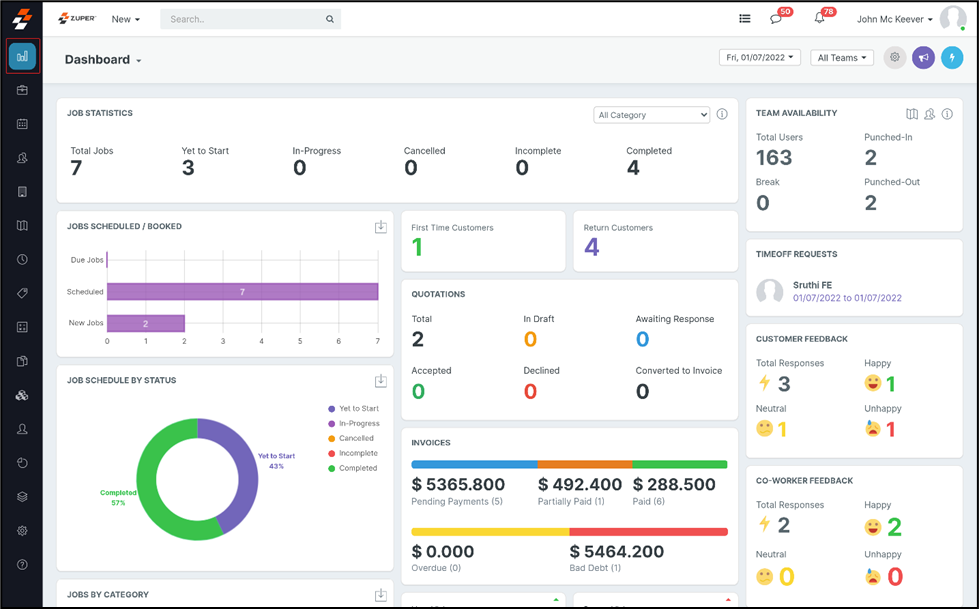It’s another busy Monday morning, and your field service dispatchers are scrambling. Over the weekend, a backlog of service requests has piled up, covering everything from appliance malfunctions to plumbing emergencies. Your team is managing priorities by matching technicians with the most emergency jobs—however, unexpected cancellations and last-minute changes are playing havoc on the schedule.
Technicians are stretched thin, and customers are starting to run out of patience. The constant battle to optimize schedules, manage resources, and keep customers satisfied is a familiar struggle for countless field service providers.
The scenario was all too common before the rise of the blended workforce. Back then, they relied on a set number of full-time technicians. Much like how Uber and DoorDash revolutionized food delivery, the integration of gig workers is transforming the field service industry. But what does this shift mean for your business? Read on.
Why does your business need gig workers?
Have you considered tapping into the gig economy for your service provider needs? Over 53% of businesses are already doing so, according to a report, and there are some pretty compelling reasons why your business should, too.
If a customer calls in with a malfunctioning furnace. In the days before the gig economy, this could play havoc with your schedule as you scrambled to find someone on staff who could run the job. While you are reallocating tasks, technicians may be late for existing calls, causing customer frustration and increased stress all around.
But with the rise of gig workers, finding someone available to run the job has become much easier. It provides a level of flexibility—that did not previously exist and puts you in a better position to meet customer demands without risk to your reputation.
Gig workers also bring specialized skills that might be hard to come by among your full-time staff. Whether it’s niche expertise or a specific task that requires extra attention, gig workers offer access to a diverse talent pool that can elevate your service quality and efficiency.
Now, let’s talk money. Incorporating gig workers into your business model allows for serious cost savings. Unlike full-time employees, gig workers don’t come with the same overhead costs. When you hire gig workers per job, the financial burden of employee benefits such as health insurance and employer-paid tax contributions can be avoided. At the same time, you can maintain a full-time workforce.
So, you can get the flexibility that allows you to hire a specific skill set when required or flesh out your workforce temporarily during the busy season. So, if you want to stay competitive in the field service industry, embracing gig workers might just be the game-changer you’ve been looking for. With their flexibility, cost efficiency, and specialized skills, gig workers can help take your business to the next level.
Why do top field service organizations hire gig workers?
When it comes to staying ahead in the competitive field service industry, top companies increasingly turn to gig workers for many reasons. First up, responding to fluctuating demand is a major challenge. Gig workers can quickly ramp up or down the workforce—no matter how busy things get, especially during peak seasons or when faced with unexpected surges in service requests.
Hiring full-time employees is good, but it comes with a fixed cost, while the workload is the same. But with gig workers, companies only pay for the work that gets done, eliminating the need for salaries, benefits, and overhead costs associated with full-time staff. It’s a win-win situation for everyone—for your business, it’s the bottom line.
Some service calls require expertise that may not be readily available within your company’s workforce. Gig platforms like Field Nation offer access to a wider talent pool, allowing you to find technicians with the exact skills needed for a particular job. So, your business can always ensure that you can consistently deliver top-notch service to your customers, no matter the complexity of the tasks.
Did you know?
As per a report, Nearly three-quarters (74%) of companies plan to contract with more gig workers or freelancers, while 28 percent actually plan to hire a greater number of gig workers than full-time employees by 2020.
Field service companies like yours often need technicians spread out across a large area to ensure prompt response times and improved customer service. With gig workers, location is no longer a barrier. You can tap into a network of technicians located anywhere, ensuring that you can meet the needs of your customers, even in remote locations.
Both companies and technicians benefit from the flexibility of the gig economy. Companies can fill scheduling gaps and handle last-minute requests with ease, while technicians have the freedom to choose their workload and work hours that fit their schedules. It’s a win-win situation that fosters a positive working relationship between you and your gig workers.
Meeting skills and growing service demand across multiple regions
You might wonder if the gig economy is possible across multiple regions. The answer is yes, you can. You can effectively meet the skills and growing demand across multiple regions by harnessing the power of the gig workforce and leveraging innovative field service management software solutions.
Gig platforms offer access to a vast network of skilled technicians from all corners of the globe. Using this global talent pool, you can quickly and efficiently find the right people for the job, regardless of geographical boundaries. You can recruit individuals with the specialized expertise needed for a job, which ensures that you can meet your customer’s diverse needs.
Thanks to advanced tools, the onboarding process for gig workers has become much simpler and more streamlined. Individuals can quickly be integrated into your workforce, saving time and money by ensuring they are ready to hit the ground running. Everyone loves success, and today’s tools can help your gig workers be successful from day one.
How can you manage gig workers?
Managing work orders can be arduous. With workers scattered across different locations, each with their own schedules and availability, juggling it all isn’t easy. If you implement the right strategies and adopt the right tools and processes, your business can streamline their work order management and ensure seamless service delivery.
To manage gig workers efficiently, field service management software is a necessary first step. You can clarify the process and eliminate the chaos caused by reliance on spreadsheets and disparate systems that were never intended to work together. Everything you need to manage your gig workers—from assigning tasks to tracking job progress—is right at your fingertips.

Keeping your workers updated is crucial, especially with gig workers. With the right FSM software, real-time updates will keep people in the loop so everyone knows what is going on at any point in time. Instant updates for job assignments and changes to existing orders are just the beginning. Simplified communication with field techs and the back offices makes it easier for everyone to stay on the same page and be agile and responsive as situations change and evolve.
When managing gig workers, communication is key. Whether it’s through chat, email, or mobile alerts FSM software provides seamless communication across various channels. Gig workers can easily reach out to supervisors, report issues, and seek assistance whenever necessary, helping to foster a collaborative and efficient work environment.
Take payrolls. Managing gig worker payroll can be a headache, especially when dealing with different payroll arrangements. Whether they are 1099 employees or working on a freelance basis, FSM software can streamline the payroll process and ensure that gig workers are compensated accurately and on time.
Onboarding
Manually onboarding and managing a revolving door of temporary and gig workers can be a nightmare. Field service management software helps streamline this process, providing a centralized platform for onboarding and managing temporary workers. From collecting necessary documentation to providing access to payment collection, FSM software saves you time and effort by ensuring that temporary workers are seamlessly integrated into your workforce.
Did you know?
According to a report, when top-performing field service organizations were asked how challenging it is to find the right talent in the gig workforce, 63% agreed that finding the right talent is easy.
Consider integrating your FSM software with an on-demand workforce management tool like Field Nation. These tools connect you with a nationwide network of skilled technicians, allowing you to tap into a wider talent pool and find the perfect fit for each job. Integrating with an FSM helps you to streamline the process of managing independent contractors, including:
- Conduct anonymous nationwide searches for qualified technicians based on specific skill sets and location needs.
- Manage a central database of all your contacts, including employees, independent contractors, third-party vendors, and customers.
- Manage contracts with third-party vendors and independent contractors, set key performance indicators (KPIs), and track work orders efficiently.
Invoicing, compliance, and performance monitoring with FSM
Managing Payments for Gig Workers
Managing payments for a diverse workforce that includes gig workers, independent contractors, and full-time employees can be complex. FSM software simplifies this process through integrated billing systems. These systems automate the invoicing process, ensuring that gig workers are paid accurately and on time for their services. By consolidating all payment information within a single platform, you can easily manage and track payments, reducing administrative burdens and minimizing errors.
Transparent Payment Processes
One of the primary concerns for gig workers is the promptness and fairness of their payments. FSM software addresses this by providing transparent payment processes. Gig workers can access their payment information through the software, see what they are being paid for each job, and track the status of their payments. This transparency builds trust and ensures that workers feel valued and fairly compensated for their efforts.
Tracking work, compliance, and generating reports
Compliance and reporting are critical aspects of managing a workforce that includes gig workers. FSM software helps you stay compliant with labor laws and regulations by tracking work hours, job completion, and other relevant data. It enables you to get generate detailed reports that provide insights into workforce performance, compliance status, and financial metrics. This functionality ensures that you can easily monitor and report on your business operations, keeping everything above board and well-documented.
Performance tracking and monitoring
Monitoring the performance of gig workers is essential for maintaining high service standards. FSM software offers robust performance tracking features, allowing you to monitor the quality of work delivered by each gig worker. You can set key performance indicators (KPIs) and use the software to track these metrics in real-time. The FSM software can also facilitate feedback systems where supervisors can provide constructive feedback to gig workers, helping them improve and maintain high standards of service delivery.
Mobile Access
Gig workers often work in the field and need to access job details, update their status, and communicate with supervisors on the go. FSM software with mobile accessibility ensures that gig workers can access all necessary information and tools from their smartphones or tablets. This mobile functionality enhances flexibility and ensures that gig workers can stay connected and productive anywhere.
Wrapping up
If you’re looking for ways to optimize your workforce without sacrificing costs, consider hiring more gig workers who suit your business needs. Businesses like you can use it to their advantage, fulfil on-demand customer requests, and deliver an exceptional customer experience.








